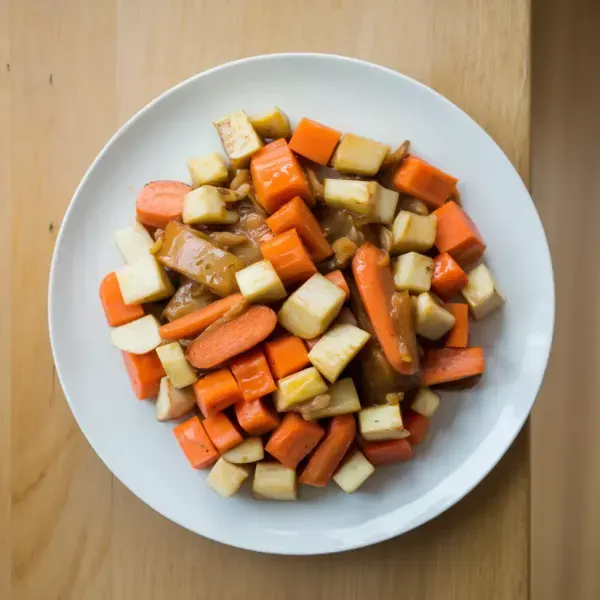
 30 minutes
30 minutesA delicious and aromatic stir-fry dish made with a variety of root vegetables, ginger, garlic, and a savory sauce.


tablespoons
Carrots, cut into 1/4-inch slices and halved or quartered if large
0 oz
Parsnips, cut into 1/4-inch slices and halved or quartered if large
0 oz
Sweet Potatoes, cut into 1/4-inch slices and halved or quartered if large
0 oz
Turnips, cut into 1/4-inch slices and halved or quartered if large
0 oz
Ginger, peeled and thinly sliced
0 oz
Garlic Clove, smashed and peeled
each
Chinese Rice Wine
cups
tablespoons
tablespoons
Dark Brown Sugar
tablespoons
Dried Chiles
each
teaspoons
Fresh Basil Leaves, torn if large
cups
1. Heat Oil
Start by heating 2 tablespoons of canola oil in a large skillet over medium-high heat until it shimmers. This shimmering indicates that the oil is hot enough to start cooking your vegetables properly.
2. Cook Vegetables, Ginger, and Garlic
Add in the 6 cups of root vegetables, 1 piece of sliced ginger, and 10 smashed garlic cloves. Cook them for about 7 to 10 minutes, stirring occasionally. You want to see the vegetables browning in spots, which tells you they are becoming crisp-tender and developing a richer flavor.
3. Add Sauce Ingredients
Once the vegetables have browned, lower the heat to medium and stir in Chinese rice wine, low-sodium soy sauce, toasted sesame oil, dark brown sugar, and either dried chiles or red-pepper flakes. Let this mixture cook for another 10 to 15 minutes, ensuring the vegetables become tender and the flavors meld together beautifully. Stir occasionally to keep everything well mixed and to prevent any sticking.
4. Add Basil and Serve
Finally, remove the skillet from the heat and stir in fresh basil leaves. Stir them in immediately so they wilt slightly and release their wonderful aroma into the dish. Serve your Root Vegetable Stir-Fry warm, and enjoy the harmony of flavors and textures that come from the perfectly cooked root vegetables and the fragrant, well-balanced sauce.
Add a tablespoon of miso paste to the glaze for a deeper umami flavor. Be mindful of the salt content, as miso is quite salty. Incorporate shiitake mushrooms or a splash of tamari for an additional umami punch.
Add tofu, tempeh, chicken, beef, or shrimp for protein. If using protein, cook it first, remove it from the pan, and then cook the vegetables. Add the protein back into the pan when you add the glaze.
Adapt the recipe to different cuisines. For example, use fish sauce, lime juice, and Thai basil in the glaze, or swap the glaze for a curry sauce made with curry powder or paste, coconut milk, and tomato.
Replace the root vegetables with other stir-fry favorites such as bell peppers, broccoli, snap peas, bok choy, onions, or mushrooms. You can also mix in leafy greens like spinach or kale at the end, just until wilted.
Introduce some heat by adding a teaspoon of chili flakes or a tablespoon of finely minced fresh chili peppers to the stir-fry. You could also incorporate a spicy element into the glaze, such as a dollop of sambal oelek or a squirt of Sriracha.
Start with the freshest root vegetables you can find. Farmers' markets are ideal for sourcing high-quality, seasonal produce. Look for vegetables with vibrant colors, firm textures, and no blemishes.
Avoid overcrowding the pan; this will steam the vegetables rather than sauté them. If necessary, cook in batches to ensure each piece has contact with the hot surface of the pan.
Stir-fry is a quick process. Have all your ingredients ready to go (mise en place) and add them to the pan in the right order – those that take longer to cook should go in first.
Use a wok or a large, heavy-bottomed skillet and make sure it's searing hot before adding your oil. This will help to achieve a good char on the vegetables, which adds depth of flavor.
Don’t skimp on the ginger, garlic, and scallions. They’re the backbone of flavor in your glaze. Fresh is best – use a microplane for the ginger and garlic to get a fine mince that will distribute flavor evenly.




Comments (0)